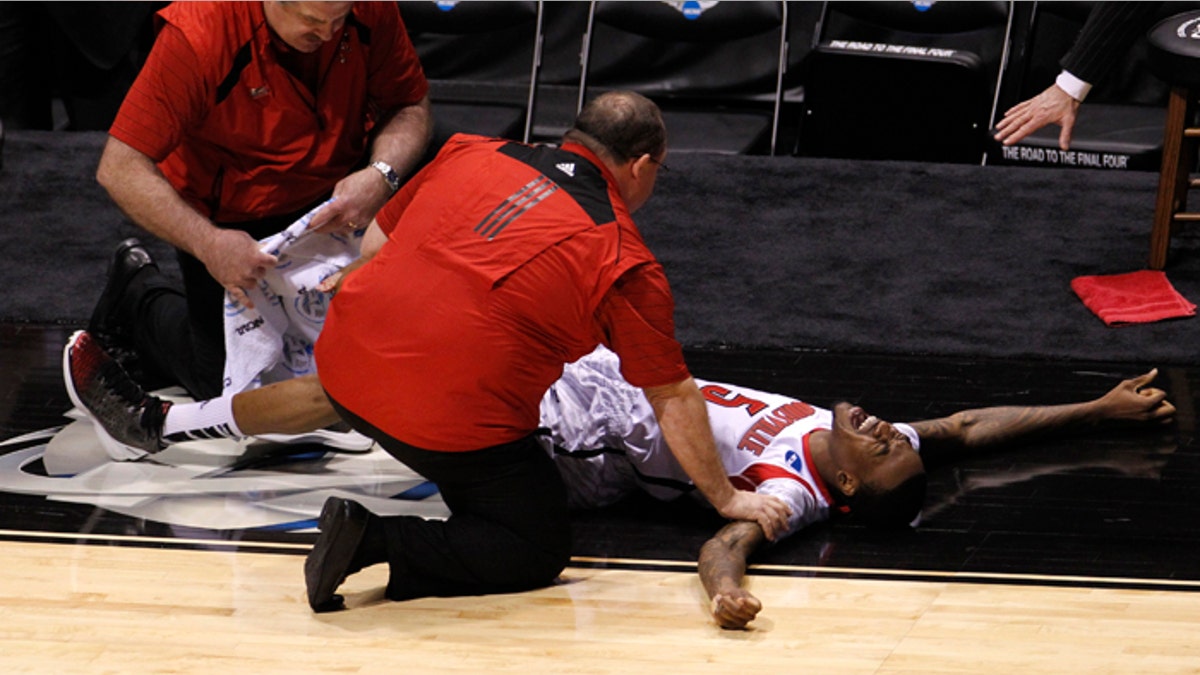
Louisville Cardinals guard Kevin Ware (5) is attended to by medical staff after breaking his leg in the first half against the Duke Blue Devils during their Midwest Regional NCAA men's basketball game. (REUTERS/John Sommers II)
During the NCAA Midwest regional final Sunday night, many spectators watched in horror as Louisville guard Kevin Ware landed awkwardly on his lower right leg – nearly bending it in a 90-degree angle.
Ware, a sophomore at Louisville, was jumping to contest a 3-point shot in the first half of the game between the Louisville Cardinals and the Duke Blue Devils, and he fell at strange angle on his way down. The fracture was so bad, his coach, Rick Pitino, said nearly six inches of bone were protruding from his leg.
According to an orthopedic surgeon, the exposed bone in Ware’s leg renders his injury an open fracture, which constitutes an orthopedic emergency.
“It looks like because of the way he landed coming down, the torque was too great, and then he landed so awkwardly,” Dr. Leon Popovitz, orthopedic surgeon and sports medicine specialist at NY Bone & Joint Specialists, told FoxNews.com. “Instead of the force going centrally through the bone like nature intended, the force went more diagonally through the bone and caused it to snap like a carrot.”
Because the force on the leg was so great, the only things holding the bone together were essentially Ware’s muscle and skin. Because these tissues weren’t powerful enough, the bone ultimately broke through the skin.
After someone suffers an open fracture, it is paramount the wound be tended to immediately.
“It needs to be treated within eight to 10 hours, because once the bone is exposed to the air and the environment, there’s a very high possibility of serious infection,” said Popovitz, who did not treat Ware.
The most devastating potential infections could be to the bone itself, which could ultimately lead to the death of the bone. Popovitz also noted that if left untreated, an open fracture could potentially lead to necrosis – or premature death of cell tissue. Because the injury is so open, the blood supply near the fracture could become compromised, causing death to the muscle and to the skin.
School officials said Ware successfully had his bone reset. In a surgery that took just two hours to complete, a rod was inserted into his right tibia to hold the bone together. However, setting an open fracture straight isn’t always so simple.
“If the tissue looks relatively healthy, the bone can be fixed all at the same time during that first operation,” Popovitz said. “But if the tissue looks dirty and compromised, and the bone fracture is in terrible fragments, doctors can chose to put on an external fixator, where they put pins on the outside of the leg – keeping the bone aligned. They come back the next day to potentially repair it then – but ultimately giving some time for the tissue and swelling to come down.”
Since Ware is still very young and healthy and was treated so quickly after the injury, Popovitz said he has a very good chance of playing basketball again at a high level – but it’s going to take some time.
“It’s probably going to take somewhere between two to three months to see significant healing, and then in the range of three months for aggressive rehabilitation,” Popovitz said. “Then it will be somewhere in the range of six to eight months before being able to return to physical activities…. So I’d say anywhere between six months to a year before he’s able to return back to normal.”
Popovitz noted it’s possible an underlying issue with Ware’s bones may have contributed to the fracture. He may have had an endocrinological disease or a cyst in the bone that happened to be at the site of the fracture. However, Popovitz speculated that the sheer force of the injury and the way Ware fell ultimately led to the severe break.
“I’d be surprised if he doesn’t have healthy, strong bones,” Popovitz said. “He was just unfortunate to have this injury. It’s probably very rare, I’ve never seen this in basketball before.”
